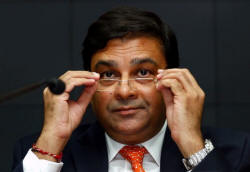|
Markets price in more
easing by Indian central bank, see risk in policy shift
 Send a link to a friend
Send a link to a friend
 [October 05, 2016]
By Suvashree Choudhury and Rafael Nam [October 05, 2016]
By Suvashree Choudhury and Rafael Nam
MUMBAI
(Reuters) - The Reserve Bank of India has embarked on a significant but
potentially risky shift towards greater tolerance of higher inflation
under new governor Urjit Patel, prompting markets to price in another
rate cut.
On Tuesday, Patel and the newly formed monetary policy panel cut the
policy rate by 25 basis points and softened the RBI's stance on the
timeline for meeting its inflation target, indicating that it had until
2021 to reach it.
And by lowering its real interest rate target to 1.25 percent, from the
1.5-2 percent band set by Patel's predecessor Raghuram Rajan, the RBI
gave itself more room to cut rates further.
The moves sent the benchmark 10-year bond yield <IN10YT=RR> down to a
more than 7-year low on Wednesday, on expectations of another rate cut,
either in December or February.
But some economists worry that a shift from Rajan's more cautious stance
could backfire should it raise doubts in the market about the bank's
management of prices, particularly while global investors are getting
used to Patel's leadership.

"The RBI has put its credibility on the line, one that was built up in
the three years prior to this under Rajan," said Shilan Shah, an
economist with Capital Economics.
"There's now an increased chance the RBI will have to reverse course
over the next 12-18 months if inflation suddenly increases, which would
be quite damaging."
Rajan and his then deputy Patel fought hard for a consumer inflation
target of 2 to 6 percent to anchor expectations in a country with a
history of volatile prices.
Having convinced the government to agree to it in 2015, Rajan set an
aggressive goal to gradually bring inflation down to 4 percent by March
2018. The target was written into law this year.
The stance earned him rebukes from within government and big business,
because critics said the goal placed too much of a constraint on
economic growth.
GLOBAL TREND
An official familiar with the RBI's thinking said Patel's stance better
reflected the flexibility provided by the government's wide-ranging
target, one that had been intended to also focus on economic growth.
Though India remains one of the world's fastest-growing major economies,
its 7.1 percent expansion in the April-June quarter from a year earlier
is below the 8 percent needed to sustain full employment.
The official added that ultra-low interest rates globally justified an
easier policy stance, with India's real interest rates now standing at
around 1.25 percent.
[to top of second column] |

The Reserve Bank of India (RBI) Governor Urjit Patel attends a news
conference after the bi-monthly monetary policy review in Mumbai,
India, October 4, 2016. REUTERS/Danish Siddiqui

"Globally, the majority of the countries are seeing huge deceleration in
inflation, and in fact are below their inflation targets. We should also
therefore have a lower neutral rate than before," said the source.
Rajan's relentless push against inflation was widely seen as a game-changer in a
country where consumer prices were rising more than 10 percent as recently as
2013.
Now, Patel and his panel, which backed him unanimously, are betting inflation
will ease further after hitting a five-month low of 5.05 percent in August after
strong monsoon rains pushed food prices lower.
For
some that marks a bold assumption at a time when the government has just raised
the salaries of millions of employees and pensioners and is gearing up to debut
a national goods and services tax that is expected to increase prices.
Nomura said it now expected the RBI to cut rates once more by February, but
questioned whether it was justified.
"We do not believe that easing is justified on economic grounds, as inflation
expectations have risen, core inflation is still sticky and there are upside
risks to inflation next year."
Uncertainty over the RBI's decision may be amplified by Patel's preference to
shun the limelight, which could make it harder to get a clear read of the bank's
policy stance.
His news briefing on Tuesday was his first public speech since his appointment
by the government in August. It lasted around 15 minutes compared with Rajan's
press conferences that would typically last 45 minutes.
(Editing by Mike Collett-White)
[© 2016 Thomson Reuters. All rights
reserved.] Copyright 2016 Reuters. All rights reserved. This material may not be published,
broadcast, rewritten or redistributed.

 |